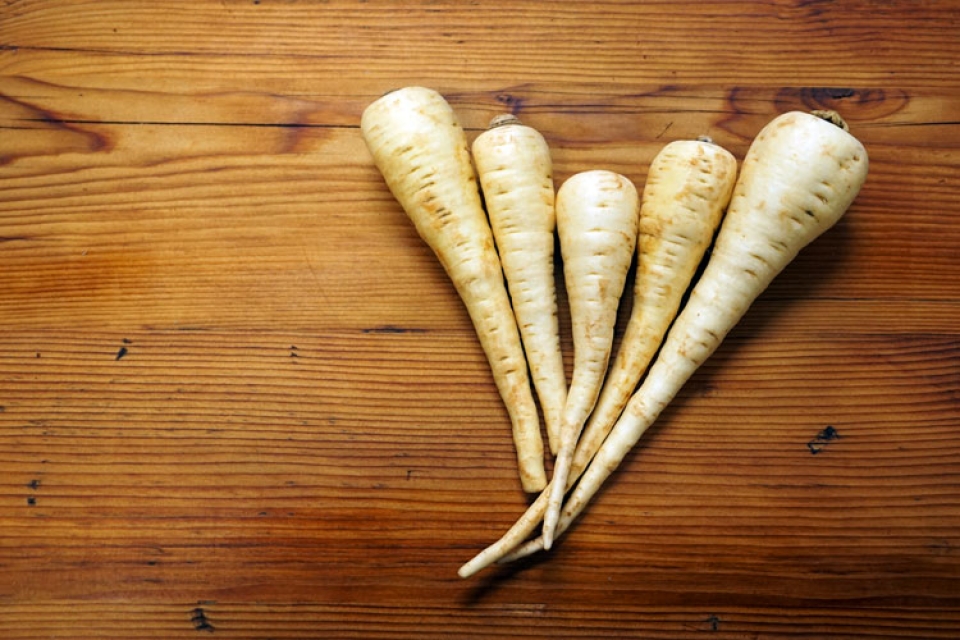Local Parsnip Perfection
Those of us living in northern climates who like to eat fresh foods during the winter are likely well-versed in root vegetables. Beets, carrots, onions, potatoes, turnips and the like are readily available to us throughout the cold months. But one can only eat so many root vegetables before they become blasé (really, how many ways can you eat turnips?).
That feeling is what inspired our annual We ♥ Local Food Recipe Contest. Each February, we host a recipe contest to celebrate and compile creative ways to use a featured ingredient that is available from local farms in the dead of winter. Last year was dried beans, the year before that was beets, and this year, we’re bringing the focus back to a perhaps under-appreciated root vegetable: parsnips!
I know – I’m sure there were some groans out there – the parsnip is not the most glamorous of vegetables. I can relate to the feeling of what may be perhaps despair or dread when you pop open your weekly CSA share only to be greeted by, you guessed it, more parsnips. But, the point of this year’s contest is to help us get out of our parsnip funk and to help us appreciate this resilient, hearty, good-for-you root vegetable.
Closely related to carrots and parsley, parsnips are high in fiber and are a good source of vitamin C, folate, and manganese. The sweetness of parsnips comes from when the vegetables’ starches change to sugar which happens after the first frost, hence why parsnips are mostly available starting in the late fall. Fun fact: in Europe, parsnips were used to sweeten (yes, sweeten!) jams and cakes before sugar was widely available. So, despite the parsnip’s reputation for only being good for roasting, this root vegetable is actually quite versatile.
If you have the creative culinary knack or have a delicious go-to parsnip recipe, enter our We ♥ Local Parsnips Recipe Contest for a chance to win a $100 City Market gift card and a Le Creuset stockpot and apron courtesy of Kiss the Cook. I challenge you to experiment and to try using parsnips in a whole new way, whether that be savory or sweet. Below are some favorite parsnip recipes to get your mouth watering and your creative inspiration flowing!This recipe was one of the top four entries in our 2011 We ♥ Local Food dessert recipe competition! Pureed parsnips make a rich base for this mousse.
1 lb parsnip
1/2 cup maple syrup
1/2 tsp lemon extract
2 tsp apple cider vinegar
1 cup non-fat lemon yogurt
1/2 cup cream
Trim ends and dark colored spots off parsnips. Boil or steam 15-20 minutes until you can easily pierce the larger pieces with a fork. Pour off cooking water and let parsnips cool.
When parsnips are cool, puree in a food processor. Next, add maple syrup, lemon extract, vinegar, and puree again. Pour into a large clean bowl and set aside.
In a separate bowl, whip the cream until stiff.
Fold the yogurt and cream into the parsnip mixture.
Serve chilled.
Parsnip Hummus
This recipe comes from http://gourmandeinthekitchen.com. While we haven’t tried this recipe, the idea of pureeing parsnips into a hummus-like dip is intriguing! Try the hummus drizzled with Garlic Chili Oil, as suggested on this page.
1 lb parsnips, peeled and cubed into 1-inch pieces
¼ cup olive oil
1 ½ tsp cumin
¼ tsp coriander
¾ tsp sea salt
2 clove garlic, large
6 Tbsp tahini
4 Tbsp lemon juice
6 Tbsp water
Fresh parsley, chopped
Simmer the parsnips with 2 Tbsp of the olive oil, cumin, coriander, salt and ¼ cup of water over medium-low heat in a medium sauté pan, stirring to coat as necessary.
Cover the pan and reduce heat to low, cooking for another 10-15 minutes until the parsnips are tender and easily pierced with the tip of a knife.
Puree the cooked parsnips along with the minced garlic, tahini, and remaining 2 Tbsp of olive oil and lemon juice in a food processor until smooth and thick, about 2 minutes, scraping down the sides of the food processor as necessary. Feel free to add additional salt or lemon juice to taste.
With the food processor running slowly, drizzle enough of the remaining water to create a light fluffy consistency (process for another 2 to 3 minutes). Spoon into a bowl and let cool to room temperature before serving.
Serve topped with fresh parsley (and garlic chili oil, if you choose) paired with chopped vegetables or crackers.
Parsnip Biscuits with Black Pepper and Honey
This recipe comes from Food52 and is another one that is new to us. It makes 10-12 biscuits.
2 cups all-purpose flour
1 tsp sea salt
1 Tbsp baking powder
¾ tsp ground black pepper
5 Tbsp cold, unsalted butter, cut into pieces
½ cup pureed cooked parsnips
5 Tbsp honey
½ cup cold buttermilk, plus more as needed
Simmer small chunks of parsnips until tender. Transfer the parsnips to a food processor and puree until smooth. Set aside.
Preheat the oven to 425 degrees F. In a medium mixing bowl, stir together the flour, salt, baking powder, and black pepper until combined. Using your fingers or a pastry cutter, blend in the cold butter until there is both coarse crumbs and pea-sized chunks.
In another bowl, whisk together the parsnip puree, honey, and buttermilk until well blended. Make a well in the middle of the dry ingredients and pour the wet ingredients into it, using a rubber spatula to scrap the bowl. Stir just until you have a shaggy dough. If the mixture seems too dry, add a little more buttermilk one spoonful at a time until the mixture comes together in a sticky, shaggy dough.
Turn the dough out onto a floured surface and pat it out into a 1-inch thick square. Cut the square in half, place one half on top of the other and pat it back down to 1-inch thick. Cut in half and stack again, patting it back down. Cut in half and stack one more time and pat it down to a 3/4 or 1-inch thick rectangle. Cut the rectangle into square biscuits (or you can cut circle biscuits). Transfer biscuits to a baking sheet.
Bake the biscuits until they're golden brown and puffed, about 13-15 minutes. Take out of the oven and transfer to a wire cooling rack. Eat warm spread with butter and honey.
Need some more inspiration? Check out all the parsnip recipes on our website.

